

Dec. 22, 2022
Showa Denko K.K.
Nippon Steel Corporation
Oita University
Osaka University
Kyoto University
Chiba University
Nagoya University
Hokkaido University
Showa Denko K.K. (President: Hidehito Takahashi, hereafter referred to as SDK), Nippon Steel Corporation
(President: Eiji Hashimoto, hereafter referred to as NSC), and six national universities (Oita University,
Osaka University, Kyoto University, Chiba University, Nagoya University, and Hokkaido University) have
jointly formed a technology development project (hereafter referred to as this Project)*1. Granted as one
of the Green Innovation Fund Projects*2 under the New Energy and Industrial Technology Development
Organization (NEDO), this Project ramped up development activities in October 2022. This project aims to
separate/capture CO2 efficiently from low-pressure/low-concentration (atmospheric pressure;
CO2 concentration: 10% or lower) discharge gas by using the technologies owned by these two
companies and six universities. With the target of achieving an innovatively low cost of 2,000-yen level
per ton, this technology is slated for social implementation in the late 2030s. Furthermore, SDK aims to
establish a business model that reuses/sells captured CO2 as raw materials of chemical
products.
The period of this Project's R&D activities is nine years from fiscal 2022 to fiscal 2030. Its budget
is approx. 8.4 billion yen in total.
Compared with high-pressure gas with a high-concentration of CO2 discharged from coal fired
power generation plants or similar facilities, low-pressure gas with a low-concentration of CO2
(atmospheric pressure; CO2 concentration: 10% or lower) discharged from plants such as those in
a petrochemical complex or steel mills has big issues such as: (1) separating CO2 selectively
is difficult, and (2) separating processes consume huge amounts of energy. For these reasons, social
implementation of CO2 separation/capture technology has not seen much progress.
This Project has a new challenging development plan that will resolve the issue described above
fundamentally by applying a structurally flexible PCP*3, which is totally different from conventional
porous materials (such as z,br/>olite and activated carbon), to the process of CO2
separation/capture from discharge gas with a low pressure and a low concentration of CO2. While
gas molecules are trapped in rigid nano-level pores of zeolite, for structurally flexible PCP, the
structure flexibly changes to take in CO2 molecules to form complexes (inclusion complexes).
Its high selectivity for CO2 is expected to be effective, because only CO2
molecules, which help form complexes stably, are captured.
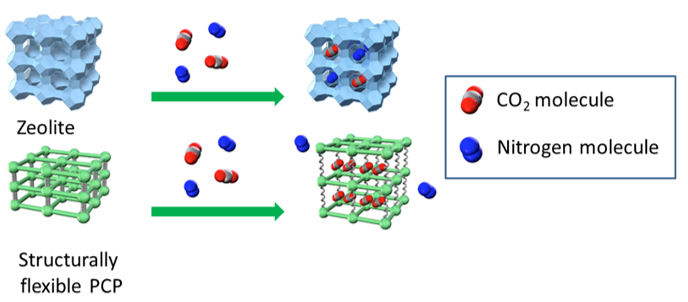
For conventional porous materials, as the green line in Figure 2 shows, the
CO2 adsorption amount increases and decreases monotonically with respect to the CO2
pressure. In this case, in order to capture CO2 adsorbed at a high pressure (point A), the
pressure has to be decreased all the way to a low pressure (point B) with a machine such as a vacuum pump.
These compression and depression operations consume large energy. On the other hand, for the material to
be developed by this Project, as the blue line in Figure 3 shows, the CO2 adsorption amount
changes sharply at a specific pressure. This peculiar behavior is called gate adsorption. When gate
adsorption is used, changing pressure slightly between points C and D can advance CO2
adsorption and desorption. Compared with conventional materials such as zeolite, this material of gate
adsorption can reduce theoretically the consumption energy significantly for separation/capture of
CO2.
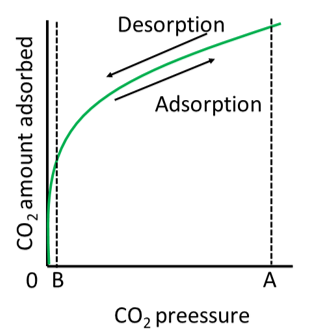
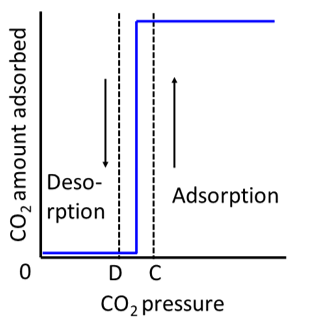
In order to achieve social implementation of the innovative CO2 separation
technology using this new material, SDK and NSC will combine the separating agent technologies each has
originally developed to develop a new revolutionary separating agent that separates CO2 from
discharge gas with a low concentration of CO2 and that is characterized by low cost and low
energy consumption during the separation process. In addition, through the co-creation process of the
joint development with Oita University, Osaka University, Kyoto University, Chiba University, Nagoya
University, and Hokkaido University, this Project aims at achieving these goals as early as
possible.
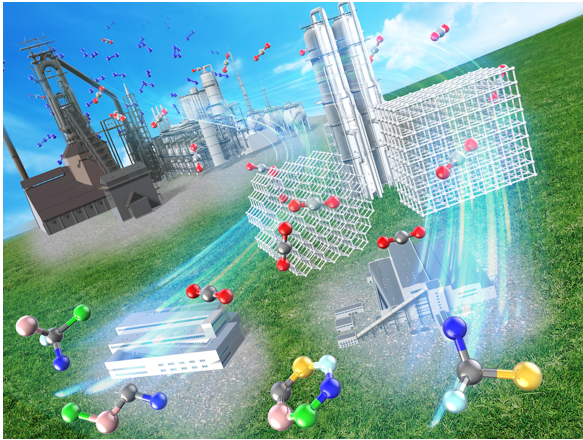
[Specific activities]
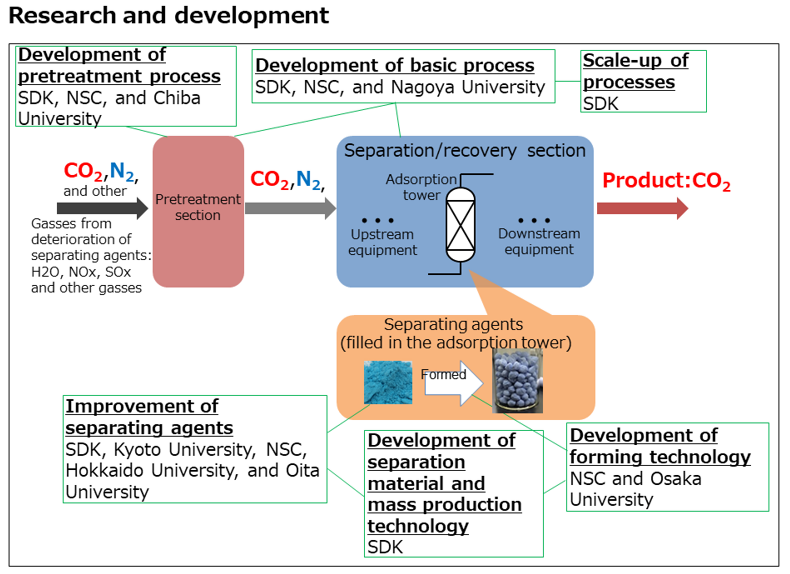
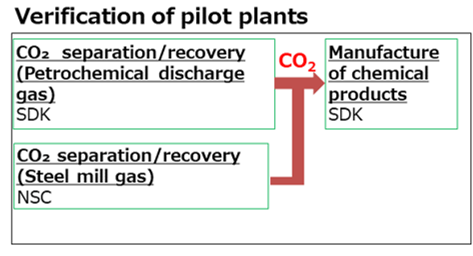
(1) Improvement of separation agent (SDK, NSC, Oita University, Kyoto
University, and Hokkaido University)
Improve the characteristics of separation agents (adsorption pressure and amount).
(2) Process development
(2)-1 Studying forming technology (NSC and Graduate School of Engineering, Osaka
University)
Develop a method for forming the separating agent into optimum shapes (development of formative
technology)
(2)-2 Gas pretreatment process development (SDK, NSC, and Chiba University)
Each company will develop/design separately the process of removing impurities that promote separating
agent deterioration to separate CO2 efficiently because components contained in gas vary
depending on emission sources.
(2)-3 Basic process development (SDK, NSC, and Nagoya University)
Optimize the processes (shapes of machines and operation conditions) that matches the special
CO2 separation behavior (gate adsorption behavior) of the structurally flexible PCP.
(2)-4 Scale-up of processes (SDK)
Based on the laboratory level basic processes, study the scale-up of processes and design a pilot plant
(machines and operation conditions).
(3) Development of separating agent mass production technology (SDK)
Study mass production technology for manufacturing several tens to several hundreds of tons of separating
agent (PCP powder and its formed bodies) in the future.
(4) Construction and verification of the pilot plants for CO2 separation (SDK
and NSC)
Verification using petrochemical discharge gas will be conducted at SDK Oita Complex, and verification
using discharge gas of steel mills at Oita Area, Kyushu Works, NSC. Both companies will verify the
productivities, selectivities, capture rates, lives of separating agents and product qualities, and assess
the economic efficiencies of the preprocesses and separating processes.
(5) Verification of the pilot plant of manufacturing chemical products (SDK)
A pilot plant will be constructed at SDK Oita Complex to manufacture chemical products using
CO2 captured from petrochemical and steel mill discharge gas each as a raw material, and
verification of manufacturing chemical products using actual gas and assessment of economic efficiency of
the plant will be carried out.
[Schedule]

Reference: NEDO's press release document (https://www.nedo.go.jp/news/press/AA5_101541.html)
*1: The formal title of the project is "Development of low-concentration CO2 separation
system using an innovative separating agent/Technology development and demonstration of small- and
medium-scale CO2 separation and capture from factory exhaust gas, etc." It was adopted in
May 2022.
*2: The formal title: "Development of Technology for CO2 Separation, Capture, etc./Green
Innovation Fund Projects"
*3: PCP abbreviation stands for Porous Coordination Polymer.